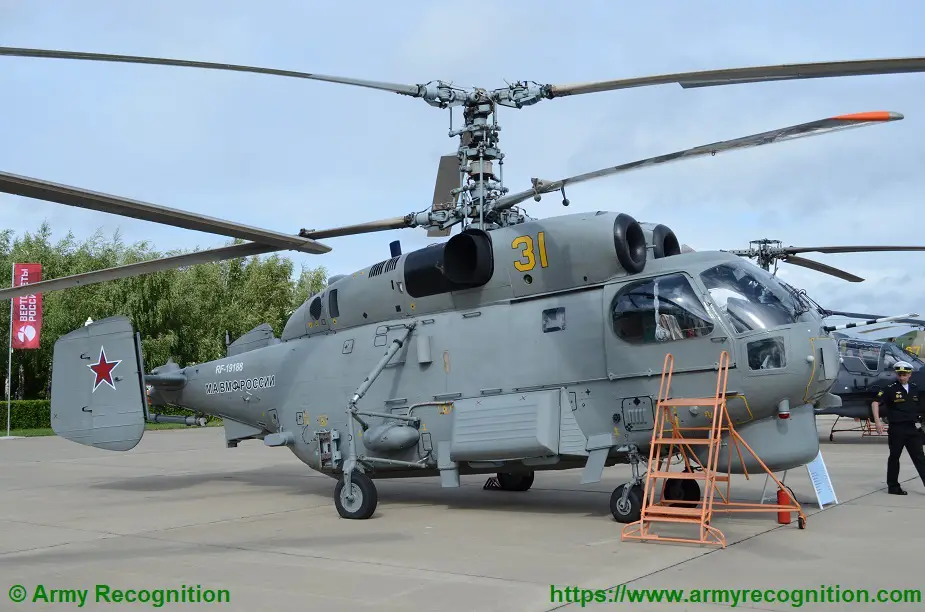Russia creates new generation of shipborne helicopter radars
The Russian naval aviation received the first Ka-27M antisubmarine helicopter in 2017. Its onboard equipment includes Fazotron Helicopter Adaptation (FHA) tactical radar designed by Fazotron-NIIR Corporation. It belongs to the family of Kopye-A onboard radars. The FHA (export option FHA01E) promotes numerous missions of an antisubmarine helicopter, the Radio Electronic Technologies magazine writes.
 Ka-27M showcased at ARMY-2017 (Picture source: Army Recognition)
Ka-27M showcased at ARMY-2017 (Picture source: Army Recognition)
The upgraded electronic equipment increased Ka-27M effectiveness several times against Ka-27. The FHA uses all the latest innovations. It has a computer comprising two units (Ts181F4 and Ts501F2), two-channel receiving tract, and a modern image reflecting system at the navigator’s seat which replaced analog indication of the navigational and tactical situation.
The radar on Ka-27M has two modules. The first one is located in the lower front part of the fuselage and the second in the middle of the helicopter. FHA01E on Ka-27M can engage in round-view reconnaissance missions at major distances and in complicated sea climate. It is air cooled.
The radar can be engaged day and night, in good and bad weather and creates images of the ground situation, sea surface in a round-view regime and a radius of 250 km. It searches for moving and stationary ground and sea objects and simultaneously determines coordinates and movement parameters of ten radio-contrast objects and keeps scanning the space. It monitors the airspace and determines coordinates of ten air objects, maps ground and sea surface, including the coastline and surface objects with a high resolution and detailed images in the assigned angle sector. It determines linear size of surface targets, detects moisture targets, controls air weapon engagement and released search equipment, exchanges information with onboard electronic equipment.
Electronics are rapidly developing and elements improve technical characteristics. Fazotron-NIIR has the necessary experience in the creation of units and radars, and proper cooperation promoted the design of a new concept of helicopter radars similar to the one on Ka-27M. They will be smaller and lighter with reliable equipment and modern computing architecture. The element base will be replaced and new technologies introduced.
Three types of Kopye-A architecture have been determined. They include a round-view with coupled slot antenna FHA02E, active phased antenna array FHA03E in two modifications, electronic (modification 1) and mechanical (modification 2) space scanning. They have one module, are similar in structure and composition and can be installed on helicopters and drones.
A single-module radar became possible after the design of new units. Ts520F1 operates as three units of FHA (data processor Ts181F4, signal processor Ts501F2, and analog-digital transformer), setup unit which acts as the generator and synchronizer.
The units have bigger technical characteristics and capabilities. The new complex has a broader reception strip, three independent receiving channels for radar signals with increased processing frequency, a major operational memory and computing speed.
The upgraded radars simultaneously track up to 20 ground and air targets, the mapping resolution rises to one meter and there is a possibility to identify air targets, such as turboprop aircraft, fighter jets, bombers and heavy airlifters, drones, helicopters, cruise missiles, surface-to-air and air-to-air missiles.
Each upgraded radar has its advantages. FHA02E has a small weight, low cost and power consumption and the antenna curtain is resistant to mechanical impacts. FHA03E of the first modification has no mechanical drivers, enjoys high reliability and a rapid change of the beam position. The second modification consumes less power, has lower weight and cost.
The unified onboard round-view radars designed by Fazotron-NIIR can be adapted for a broad range of aircraft, including drones, and engage in a broad range of missions, such as sea, air and ice reconnaissance, rescue operations, weather monitoring for civilian and military flights, the Radio Electronic Technologies magazine said.
© Copyright 2020 TASS. All rights reserved. This material may not be published, broadcast, rewritten or redistributed.


























